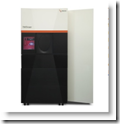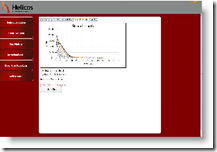Patrice Milos, Vice President and Chief Scientific Officer, Helicos BioSciences 
 This week I had the opportunity to talk with Patrice Milos from Helicos BioSciences who has a long background in global research and spent a number of years at Pfizer as Executive Director at Pfizer Global Research and Development prior to working at Helicos. Her focus has been Cardiovascular and Metabolic Disease, Pharmacogenomics, DNA Sequencing, Biomarkers and Molecular Sciences. The interview and conversation offered some very unique views of how genetics and the drug industry are collaborating to make personalized medicine a more prevalent option in the healthcare industry. Before getting started I also wanted to make note of Helicos being in the news this week with their new collaboration efforts with a University in Sweden and more can be read here.
This week I had the opportunity to talk with Patrice Milos from Helicos BioSciences who has a long background in global research and spent a number of years at Pfizer as Executive Director at Pfizer Global Research and Development prior to working at Helicos. Her focus has been Cardiovascular and Metabolic Disease, Pharmacogenomics, DNA Sequencing, Biomarkers and Molecular Sciences. The interview and conversation offered some very unique views of how genetics and the drug industry are collaborating to make personalized medicine a more prevalent option in the healthcare industry. Before getting started I also wanted to make note of Helicos being in the news this week with their new collaboration efforts with a University in Sweden and more can be read here.
One area we both strongly agreed upon is the use of software, from a data person like myself and with Dr. Milos with her area of research, we both absolutely concur that software is what makes all of this possible. Being that I have readers from all areas of the Internet, this interview is done in the interest of trying to keep things as simple as possible to be able to give all readers some valuable information and insight into what is happening in the world of genomics and personalized medicine.
Helicos BioSciences, a life science company focused on genetic analysis technologies for the research, drug discovery, and diagnostic markets, has announced a scientific collaboration with a genomics research group at Sweden's Uppsala University aimed at gaining new insights into how genome structure plays a key role in the ways genes are regulated within cells. The Uppsala team, will work with Helicos scientists on a research plan designed to utilize Helicos' proprietary True Single Molecule Sequencing (tSMS) technology to investigate changes in the cell nucleus that occur in the presence of growth factors.
And on with the interview:
First of all, How large is the facility and how many technicians and employees work for Helicos?
Helicos has 3 facilities in the Cambridge, Massachusetts area, with approximately 120 employees. One houses the administrative offices and the other two facilities are for research and product development. Helicos opened the doors for business in the year 2003.
What exactly is a gene sequence?
 Gene sequencing is a whole new vision to define enzyme actions. Much of my past work at Pfizer involved research with Lipitor. We are finding that research with RNA is much more complex than anyone imagined. RNA (ribonucleic acid) is responsible for translating the genetic code of DNA into proteins. There really is no simple way to explain the process, but it enables the transcription of genetic information and the production of new proteins to give an interpretation of protein synthesis within a cell. Helicos is the first genetic analyzer to utilize single molecule sequencing. Research and development has been going on for a number of years in this area, but only recently is there more of a public awareness with the recent discoveries and breakthroughs.
Gene sequencing is a whole new vision to define enzyme actions. Much of my past work at Pfizer involved research with Lipitor. We are finding that research with RNA is much more complex than anyone imagined. RNA (ribonucleic acid) is responsible for translating the genetic code of DNA into proteins. There really is no simple way to explain the process, but it enables the transcription of genetic information and the production of new proteins to give an interpretation of protein synthesis within a cell. Helicos is the first genetic analyzer to utilize single molecule sequencing. Research and development has been going on for a number of years in this area, but only recently is there more of a public awareness with the recent discoveries and breakthroughs.
Pharmacogenomics is the new term for much of the research in process, is this the same as Personalized Medicine and how does it relate?
Pharmacogenomics is the ability to understand risk. With genomic research we are able to find the right medication for patient treatment plans, and know up front what side effects may be present. Expression analysis allows this to occur, and examines the single gene interactions with drugs. Drugs as well as drug combinations are optimized for each individual's unique genetic makeup and creates a plan which is called "Personalized Medicine", in other words a plan created specially for each patient created to avoid potential dangerous side effects along with determining how effective the medications will be for the individual.
How does the technology help with drug development?
Pharmaceutical companies today must have an interest in the Biotech Industry to survive. I had a very active role at Pfizer as well over the  years in getting the movement started in this direction. Biotech ends up being somewhat of a "service" business for the Pharmaceutical industry. We have spoken and worked with many pharmaceutical companies and will continue this effort with research and development. The market is changing rapidly today and without Biotech and genomics, it would be difficult to survive today based on methodologies used in the past.
years in getting the movement started in this direction. Biotech ends up being somewhat of a "service" business for the Pharmaceutical industry. We have spoken and worked with many pharmaceutical companies and will continue this effort with research and development. The market is changing rapidly today and without Biotech and genomics, it would be difficult to survive today based on methodologies used in the past.
I spend much of my time speaking and spreading the word of genomics to many universities. Education and enlightening others is the key to the success of personalized medicine. The technology is moving faster today than we ever imagined, and thus the training and education processes need to be in high gear.
What are the focus areas of research for Helicos? Cancer? Others?
Yes, cancer is a big area of focus for Helicos, cancerous tumors in particular of interest. There are many samples, etc. that can be researched and studied. Labs, etc. have tumors that have been removed from individuals that can offer much in the area of research. Any samples we can secure and study are obviously a real plus to unlocking additional information that can be utilized to help in the research of genomic studies, as the more information that can be gained up front, it makes for a better patient treatment plan, or in the pharmaceutical area, it helps in the complicated process of creating a drug that will create a high level of success in combating cancer.
When studies are conducted, are all interpretations going to be equal, in other words the same samples with the same expressions reviewed from different sources, will the conclusions be the same?
That is a very good question and something I speak about often. The field is still very young and new information is gathered daily. As the field of genomics and personalized medicine grows there may be more of this type of activity with several interpretations taking place. It's hard to give a solid answer as to how this will unveil in time, but it is an awareness that is discussed quite frequently. I currently serve on the National Advisory Council for Human Genome Research as well as contributing to editorial boards for journals and have published and presented extensively in the genomics area.
What is the HeliScopeTM Single Molecule Sequencer?
The best way to describe the HeliScopeTM Single Molecule Sequencer that is it is about the size of a big "freezer". This is the machine that sequences and runs the genomic expressions to deliver the results. It functions by capturing images to observe sequencing-by-synthesis reactions for billions of individual DNA molecules. It produces digital data and produces over 2 Gigabases of sequence data per day. It is a DNA microscope and has a touch screen interface for the end users.
 Tell me a little about the software, how does it work? I hear some of the same familiar words that I am familiar with from the computer code side of things, like expressions, arrays, items that I am familiar with.
Tell me a little about the software, how does it work? I hear some of the same familiar words that I am familiar with from the computer code side of things, like expressions, arrays, items that I am familiar with.
It is a web based application that also can be accessed remotely. In other words there's no need to be present at the facility to view results and run reports.
In essence, the software application is the brain and functions much like any other software application in the fact that it has an administrator to design and set parameters to derive and generate the desired data. The control center can also be used to monitor more than one machine.
What is a flow cell?
The flow cells are a part of the process used to grow the DNA, it contains images of the end strands of and later it can be downloaded into a flat file. To run a full sequence at present it takes approximately 6 weeks to gain the full study with 5 to 10 runs. This is an area of focus to where we are working to bring this time element down to a shorter duration, in other words, with shortening the processing time, results and data can be evaluated at a faster pace and made available, valuable as an example for clinical trials. Shortening the process time is a primary focus and the demand for this is high. The ongoing development of the software is the key to making this happen.
flat file. To run a full sequence at present it takes approximately 6 weeks to gain the full study with 5 to 10 runs. This is an area of focus to where we are working to bring this time element down to a shorter duration, in other words, with shortening the processing time, results and data can be evaluated at a faster pace and made available, valuable as an example for clinical trials. Shortening the process time is a primary focus and the demand for this is high. The ongoing development of the software is the key to making this happen.
I read where Helicos is similar to being compared to the "Intel chip", could you elaborate on this a little, what sets Helicos apart from some of the competition, is the advanced R and D research similar to processing chips with making the progression somewhat modular and using a smaller amount of space?
Certainly the process shares the same underlying theories, to be able to secure and attain more information in a smaller space. Using single cell processing is part of what is allowing this area of development to grow.
I depend on my family physician to help guide me with my healthcare, and I am curious as to what is being done to help educate the medical community on how to use and relay this information to me, as a patient, what is being done from the education side of things to help the physicians to take advantage and use this information for better healthcare? Will some of this information end up in my chart?
I spend a great deal of my time with interacting and lecturing at many universities to help bring this to the forefront. You are correct that this is an area needing to be addressed and quickly as the pace of growth continues to be accelerated compared to what we have experienced in the past. One example that has been in the news lately is the use of the drug "Warfarin" also know as by a common brand name Coumadin; about 10% of drugs approved by the FDA include pharmacogenomic information on their labels.
Responses may depend not on a single gene but, rather, on multiple genes. Genomic biomarkers help identify which patients will or will not benefit from certain drugs. Warfarin sensitivity tests have been cleared by the FDA as an aid to identify patients at risk for increased sensitivity to the widely used blood-thinning drug. This information can help avoid serious bleeding events and the event of a potential stroke.
For physicians charting this type of information, one of the first areas that could be explored would encompass drug metabolism information. This is a potential area that a software vendor could begin investigating today in reference to incorporating this information in to an electronic medical record system. All this will need to be provided in a format that will allow the physician to view and evaluate this information quickly in the fast paced world of the family practice physician in particular.
Where does the money come from for research? Is it grants, private donations?
Revenue comes from both areas. Venture capitalists play a huge role today in helping finance the research and development and much of the information we have today would not be possible if it were not for their investments. Grants of course play a very vital role as well, and sometimes it turns into quite a lengthy process, as the bar for applying and receiving grants has risen. I currently sit on a board that reviews and discusses the process, and some of the areas we look at for example deal with having made the right decisions, in plain English, are the right decisions being made to direct the grants in the appropriate direction, which can be complicated at times and requires some very detailed information to be reviewed.
What is the market for the HeliScopeTM Single Molecule Sequencer? Where does the product make it's entry in to the field of research and development?
As mentioned above, Helicos and the Uppsala University have a very important relationship and collaboration, Uppsala has not ordered a HeliScopeTM Single Molecule Sequencer; however a second order has recently been secured from a U.S. cancer center.
In March, we announced our first shipment to Expression Analysis of Durham, North Carolina. The sales was predicated on accuracy of its single molecule sequencing as discussed above. Expression Analysis is a leading provider of genomic services in clinical trials and research and the HeliScopeTM Single Molecule Sequencer fits right into the future plans in being the core element that will enable them to offer genome analysis at or below the $1,000 in the future.
Beyond the services offered by the analysis firms, universities and anyone involved in genomic research is certainly a target market for us to provide the products and software to make it all happen. It's a very fast paced world growing today that is not only impacting the way medicine is practiced, but how we live our lives.
End of interview....
I want to personally thank Dr. Milos for taking time to speak with me today. I certainly learned quite a bit today and have a much better understanding of how the world of genomics is changing and what companies such as Helicos are doing to promote and drive these processes and bring personalized medicine to the forefront. I hope my readers also find this information to be both helpful and informative. BD
Additional reading and information can be found at the Helicos website.



The information that was given in your blog is good.It helped me a lot for knowing new things.
ReplyDelete